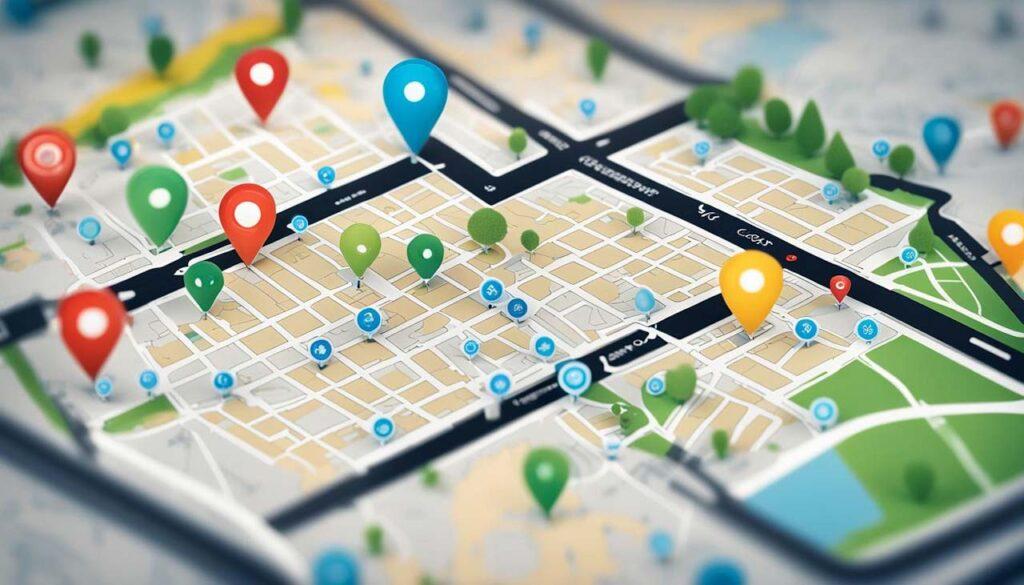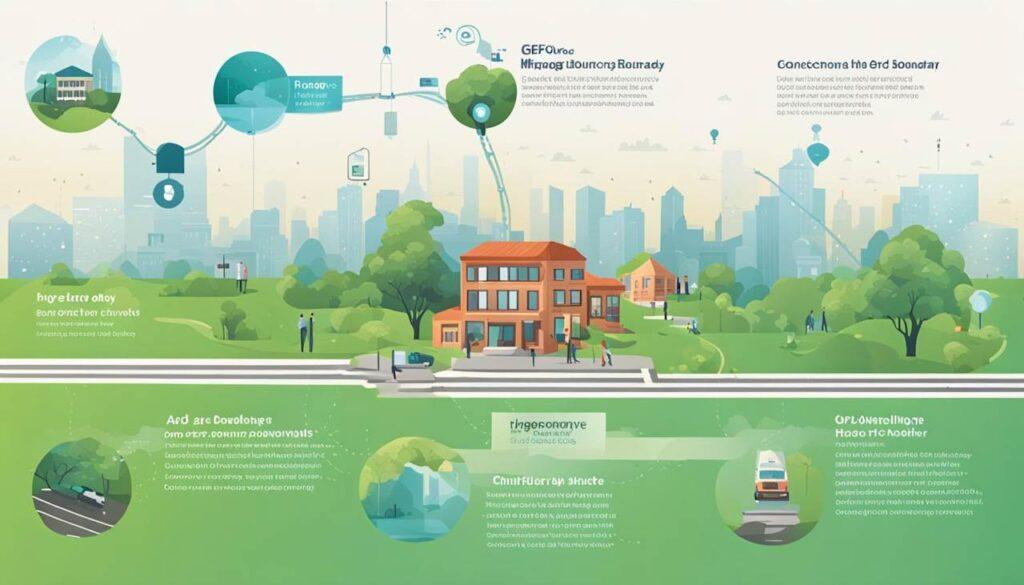Location based advertising has transformed the way local businesses connect with their target audience. By leveraging the power of geolocation technology, these businesses can reach potential customers in their vicinity and establish a direct line of communication.

One of the key benefits of location based advertising is its ability to increase foot traffic to local stores. By targeting individuals who are in close proximity to the business, these campaigns can effectively drive customers through the doors and boost sales.
Furthermore, location based advertising allows local businesses to create personalised and relevant messages for their audience. By understanding the specific location of their customers, businesses can tailor their advertisements to include information that is most valuable to them.
This hyper-targeted approach not only increases the likelihood of engagement but also helps businesses build a stronger relationship with their customers. Whether it’s offering a limited-time discount for nearby customers or promoting a special event just around the corner, this level of personalisation enhances the overall customer experience.
Targeting the Right Audience with Location Based Advertising
Location based advertising offers a powerful tool for businesses to effectively target their desired audience. By leveraging real-time location data, businesses can deliver tailored advertisements to potential customers in specific geographic areas.
This enables local businesses to connect with consumers who are physically present in the vicinity of their business, making it more likely that the advertisement will successfully capture their attention and drive them to take action.

One of the key advantages of location based advertising is its ability to reach a highly relevant audience. With this strategy, businesses can ensure that their ads are only displayed to individuals who are in close proximity to their physical location or have shown an interest in similar products or services.
This targeted approach not only increases the chances of attracting potential customers but also maximises the return on investment for advertising budgets. By targeting the right audience, businesses can deliver messages that resonate with their target market and are more likely to lead to conversions or sales.
Effective Strategies for Location Based Advertising
One effective strategy for location based advertising is to leverage real-time data. By utilising GPS and other location-tracking technology, businesses can gather valuable information on their target audience’s behaviour and preferences. This data can then be used to deliver highly relevant and personalised ads to consumers in real-time, increasing the chances of engagement and conversion.

Another successful strategy is to create interactive and immersive experiences for consumers. Location based advertising allows businesses to provide customised and contextual experiences to their audience.
For example, a retail store can send personalised offers and recommendations to customers as they walk by the store, encouraging them to step inside and make a purchase. By creating interactive experiences that tap into the immediate surroundings of consumers, businesses can effectively capture attention and drive action.
Best Practices for Creating Location Based Advertising Campaigns
Location based advertising campaigns can be highly effective in reaching local consumers and driving foot traffic to businesses. To create successful campaigns, it is crucial to follow best practices that align with your marketing goals and target audience.

First and foremost, it is essential to thoroughly research and understand your target audience. Take into consideration their demographics, interests, and behaviour patterns. By gaining this insight, you can create tailored advertisements that resonate with your audience and drive higher engagement.
Furthermore, it is crucial to leverage the power of data and analytics to inform your decision-making process. Monitor and analyse the performance of your campaigns regularly, adjusting your strategy as needed to optimise results. By staying data-driven, you can continuously improve and refine your location-based advertising campaigns for maximum impact.
Understanding the Role of Geofencing in Location Based Advertising
Geofencing plays a crucial role in driving the success of location based advertising campaigns. By definition, geofencing is a technology that allows businesses to establish virtual boundaries, or “fences,” around a specific geographic area. These boundaries are created using GPS or RFID technology and can be as large as a city or as small as a single building.

One of the main benefits of geofencing is its ability to deliver targeted messages to consumers based on their precise location. This means that businesses can send customised advertisements or promotions to people who are within the designated area.
For example, a coffee shop can use geofencing to send a special discount offer to individuals passing by their store. By doing so, they can entice potential customers to come in and enjoy a cup of coffee, while also increasing foot traffic to their location.
Overall, geofencing allows businesses to connect with their target audience in a location-specific manner, increasing the chances of conversions and ultimately driving business growth.
Utilising Geotargeting to Improve Location Based Advertising Results
Geotargeting is a powerful tool that can greatly enhance the effectiveness of location-based advertising campaigns. By utilising geotargeting, businesses are able to narrow down their audience and deliver tailored advertisements to specific geographic regions. This precision targeting ensures that the right message reaches the right people at the right time, increasing the likelihood of engagement and conversion.

One of the key benefits of geotargeting is its ability to optimise advertising budgets. By targeting specific locations, businesses can avoid wasting resources on audiences that are unlikely to be interested in their products or services. Instead, they can focus their efforts on areas where there is a higher concentration of potential customers, maximizing their return on investment.
Furthermore, geotargeting enables businesses to capture local market opportunities, as they can easily tailor their advertisements to cater to the needs and preferences of specific regions. This localised approach helps to build trust and rapport with the target audience, ultimately leading to increased brand loyalty and customer retention.
- Geotargeting allows businesses to deliver tailored advertisements to specific geographic regions
- Precision targeting increases the likelihood of engagement and conversion
- Optimises advertising budgets by avoiding wasted resources on uninterested audiences
- Focuses efforts on areas with a higher concentration of potential customers
- Maximises return on investment
- Captures local market opportunities by catering advertisements to specific regions
- Builds trust and rapport with target audience
- Increases brand loyalty and customer retention
Measuring the Success of Location Based Advertising Campaigns
In the world of marketing, measuring the success of any advertising campaign is crucial to understanding its impact and effectiveness. This holds true for location-based advertising as well. When it comes to measuring the success of location-based advertising campaigns, businesses have access to valuable data and tools that can help them track and analyse their results.

One of the key metrics that businesses can use to measure the success of their location-based advertising campaigns is foot traffic. By analysing the number of people who visit a physical store after being exposed to a location-based ad, businesses can gauge the effectiveness of their advertising efforts.
This data can be collected through various methods, such as tracking in-store purchases, utilising mobile apps that track user locations, or even deploying beacons that communicate with customers’ smartphones. Businesses can learn about the effectiveness of their location-based ads in attracting store visits, helping them to make better decisions for future advertising strategies.
Common Mistakes to Avoid in Location Based Advertising
One of the most common mistakes to avoid in location-based advertising is failing to accurately define the target audience. It is crucial to understand the specific demographics, interests, and behaviours of the audience you are trying to reach.
Without this essential knowledge, your advertising efforts may be ineffective and fail to resonate with the intended recipients. A thorough analysis of data and market research can help you identify the right audience and tailor your messaging accordingly.
Another mistake to avoid is neglecting to optimise your location-based advertising campaigns. In today’s digital landscape, consumers are constantly bombarded with advertisements, making it crucial to stand out from the competition. Failing to optimise your campaigns for maximum visibility can result in poor performance and wasted resources.
Consider factors such as timing, relevance, and creativity when designing your advertisements to ensure they capture attention and prompt action from your target audience.

How to Choose the Right Location Based Advertising Platform for Your Business
When it comes to choosing the right location based advertising platform for your business, there are a few key factors to consider.
First and foremost, you need to think about your target audience and their behaviour. Understanding where your customers are located and how they interact with mobile devices will help you determine the best platform to reach them.
Secondly, you should consider the features and capabilities of each platform. Look for a platform that offers geotargeting, geofencing, and real-time data analytics. These features will allow you to create highly targeted and effective location-based advertising campaigns.
Furthermore, it is important to consider the ease of use and user interface of the platform. You want a platform that is intuitive and user-friendly, as this will save you time and make managing your campaigns easier.
Lastly, don’t forget to take into account the cost of the platform. Consider your budget and how much you are willing to spend on location-based advertising. Evaluate the pricing structure of each platform and compare it to the features and benefits it offers.
Overall, choosing the right location-based advertising platform for your business requires careful consideration of your target audience, platform features, ease of use, and cost. By weighing these factors, you can make an informed decision that will help you effectively reach your local customers.
Future Trends and Innovations in Location Based Advertising
With advancements in technology and the expanding use of mobile devices, the future of location-based advertising appears promising. One of the emerging trends is the integration of augmented reality (AR) into location-based advertising campaigns.

AR technology allows businesses to overlay digital content on real-world environments, providing immersive and interactive experiences for users. By utilising AR in their advertising strategies, businesses can engage with consumers in a more captivating and memorable way, ultimately driving higher conversion rates.
Another future trend in location-based advertising is the integration of artificial intelligence (AI) and machine learning algorithms. These technologies can analyse vast amounts of data, enabling businesses to segment their target audience more effectively and deliver personalised advertisements based on users’ preferences and behaviours.
Moreover, AI-powered chatbots can provide real-time assistance to consumers, answering their queries and guiding them towards making a purchase. As AI continues to improve, location-based advertising will become more intelligent, efficient, and tailored to meet the individual needs of customers.
Location Based Advertisements FAQ
What are the benefits of location based advertising for local businesses?
Location based advertising allows local businesses to target nearby customers and increase foot traffic, boost brand awareness, and improve customer engagement and loyalty.
How can location based advertising help businesses target the right audience?
Location based advertising utilises geolocation data to target individuals within a specific geographic area, ensuring that businesses can reach their desired audience with relevant and personalised ads.
What are some effective strategies for location based advertising?
Strategies for location based advertising include utilising real-time location data, creating compelling and personalised content, leveraging proximity marketing techniques, and partnering with relevant location-based apps or platforms.
What are some best practices for creating location based advertising campaigns?
Best practices for creating location based advertising campaigns include understanding the target audience’s preferences and behaviours, optimising ads for mobile devices, providing clear calls-to-action, and continuously analysing and optimizing campaign performance.
What is the role of geofencing in location based advertising?
Geofencing is a technology that allows businesses to set up virtual boundaries, or perimeters, around a specific location. It enables targeted advertising to individuals who enter or exit these predefined boundaries, increasing the relevance and effectiveness of location-based ads.
How can geotargeting improve location based advertising results?
Geotargeting allows businesses to narrow down their advertising efforts by targeting specific demographic segments or user behaviours within a defined geographic area. This precision targeting helps improve the relevance and efficiency of location based advertising.
How can the success of location based advertising campaigns be measured?
The success of location based advertising campaigns can be measured through metrics such as foot traffic, customer engagement, conversion rates, click-through rates, and the overall return on investment (ROI).
What are some common mistakes to avoid in location based advertising?
Common mistakes in location-based advertising include neglecting to optimise ads for mobile devices, not considering the context of the user’s location, failing to segment and personalise ads, and not regularly analysing and optimising campaign performance.
How can businesses choose the right location based advertising platform?
Businesses should consider factors such as the platform’s targeting capabilities, reach and audience size, available ad formats, reporting and analytics features, and integration options with other marketing tools before choosing a location based advertising platform that aligns with their specific needs.
What are some future trends and innovations in location based advertising?
Some future trends and innovations in location based advertising include the integration of augmented reality (AR) and virtual reality (VR) technologies, the use of artificial intelligence (AI) for better audience targeting, and the incorporation of wearable devices and Internet of Things (IoT) technology for enhanced personalisation and real-time engagement.
Conclusion
Location based advertising stands as a transformative force for local businesses, offering unparalleled opportunities to connect with their target audience in a highly personalised and efficient manner. By harnessing the power of geolocation technology, businesses are now able to engage potential customers with pinpoint accuracy, thereby enhancing foot traffic, sales, and ultimately, customer loyalty.
The strategies and best practices outlined in this article provide a roadmap for leveraging location based advertising to its fullest potential, emphasising the importance of understanding your audience, utilising real-time data, and continually optimising campaigns for the best possible outcomes.
Moreover, the role of technologies such as geofencing and geotargeting cannot be overstated, as they significantly amplify the effectiveness of location based advertising by enabling businesses to deliver messages that are not just timely but also deeply relevant to the consumer’s current context.
As we look to the future, the exciting integration of augmented reality and artificial intelligence promises to further revolutionise this space, offering even more engaging and personalised advertising experiences that are likely to redefine customer engagement in profound ways.
For local businesses keen on staying ahead in today’s competitive market, embracing location based advertising is not just an option but a necessity. By choosing the right platform, understanding the intricacies of geolocation technologies, and adhering to proven best practices, businesses can unlock the full potential of this dynamic marketing strategy.
As technology evolves, so too will the ways in which businesses connect with their customers, making location based advertising an ever-more critical tool in the marketing arsenal of modern businesses.



